lights FORD FIESTA 1989 Service User Guide
[x] Cancel search | Manufacturer: FORD, Model Year: 1989, Model line: FIESTA, Model: FORD FIESTA 1989Pages: 296, PDF Size: 10.65 MB
Page 237 of 296
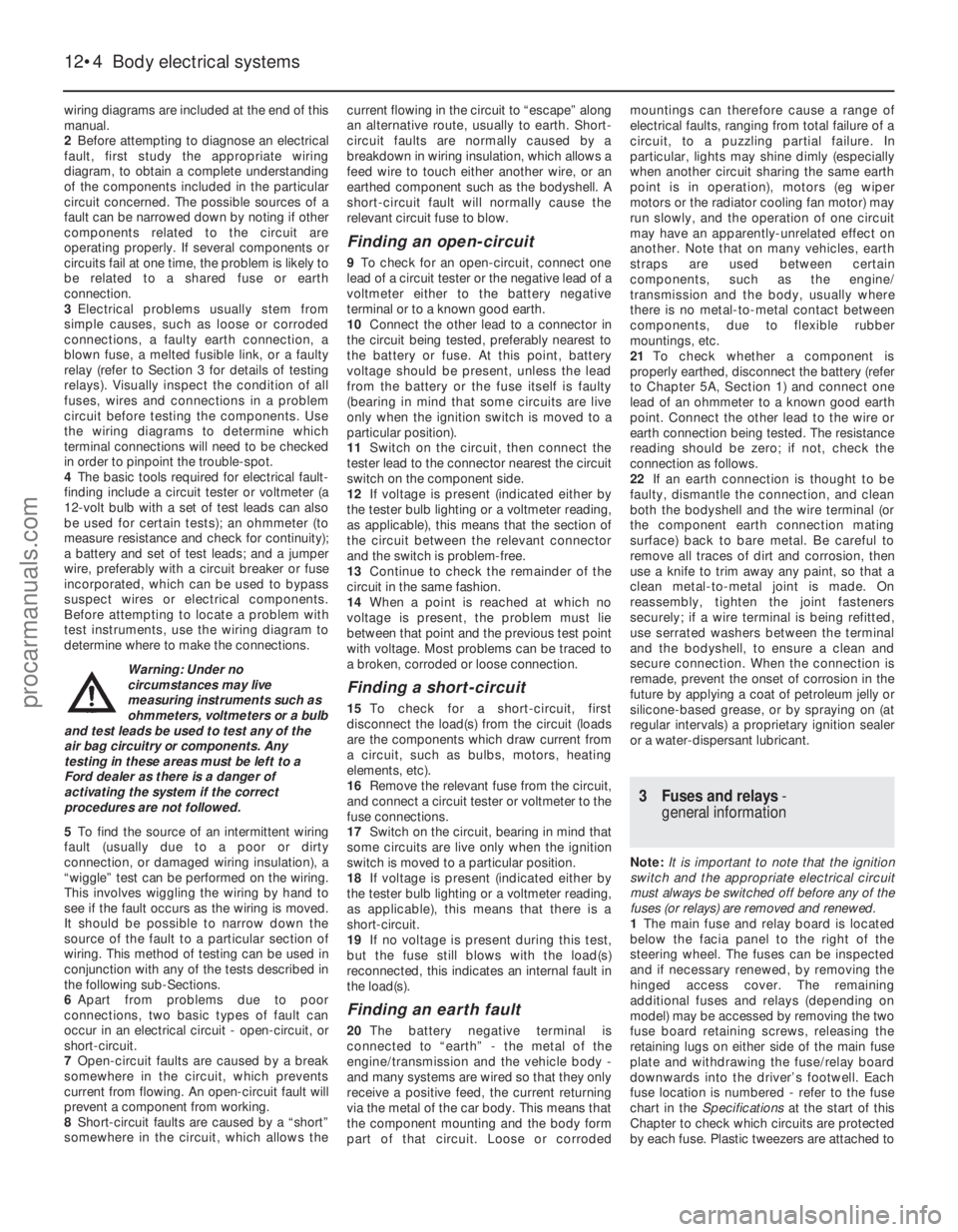
wiring diagrams are included at the end of this
manual.
2Before attempting to diagnose an electrical
fault, first study the appropriate wiring
diagram, to obtain a complete understanding
of the components included in the particular
circuit concerned. The possible sources of a
fault can be narrowed down by noting if other
components related to the circuit are
operating properly. If several components or
circuits fail at one time, the problem is likely to
be related to a shared fuse or earth
connection.
3 Electrical problems usually stem from
simple causes, such as loose or corroded
connections, a faulty earth connection, a
blown fuse, a melted fusible link, or a faulty
relay (refer to Section 3 for details of testing
relays). Visually inspect the condition of all
fuses, wires and connections in a problem
circuit before testing the components. Use
the wiring diagrams to determine which
terminal connections will need to be checked
in order to pinpoint the trouble-spot.
4 The basic tools required for electrical fault-
finding include a circuit tester or voltmeter (a
12-volt bulb with a set of test leads can also
be used for certain tests); an ohmmeter (to
measure resistance and check for continuity);
a battery and set of test leads; and a jumper
wire, preferably with a circuit breaker or fuse
incorporated, which can be used to bypass
suspect wires or electrical components.
Before attempting to locate a problem with
test instruments, use the wiring diagram to
determine where to make the connections.
Warning: Under no
circumstances may live
measuring instruments such as
ohmmeters, voltmeters or a bulb
and test leads be used to test any of the
air bag circuitry or components. Any
testing in these areas must be left to a
Ford dealer as there is a danger of
activating the system if the correct
procedures are not followed.
5 To find the source of an intermittent wiring
fault (usually due to a poor or dirty
connection, or damaged wiring insulation), a
“wiggle” test can be performed on the wiring.
This involves wiggling the wiring by hand to
see if the fault occurs as the wiring is moved.
It should be possible to narrow down the
source of the fault to a particular section of
wiring. This method of testing can be used in
conjunction with any of the tests described in
the following sub-Sections.
6 Apart from problems due to poor
connections, two basic types of fault can
occur in an electrical circuit - open-circuit, or
short-circuit.
7 Open-circuit faults are caused by a break
somewhere in the circuit, which prevents
current from flowing. An open-circuit fault will
prevent a component from working.
8 Short-circuit faults are caused by a “short”
somewhere in the circuit, which allows the current flowing in the circuit to “escape” along
an alternative route, usually to earth. Short-
circuit faults are normally caused by a
breakdown in wiring insulation, which allows a
feed wire to touch either another wire, or an
earthed component such as the bodyshell. A
short-circuit fault will normally cause the
relevant circuit fuse to blow.
Finding an open-circuit
9
To check for an open-circuit, connect one
lead of a circuit tester or the negative lead of a
voltmeter either to the battery negative
terminal or to a known good earth.
10 Connect the other lead to a connector in
the circuit being tested, preferably nearest to
the battery or fuse. At this point, battery
voltage should be present, unless the lead
from the battery or the fuse itself is faulty
(bearing in mind that some circuits are live
only when the ignition switch is moved to a
particular position).
11 Switch on the circuit, then connect the
tester lead to the connector nearest the circuit
switch on the component side.
12 If voltage is present (indicated either by
the tester bulb lighting or a voltmeter reading,
as applicable), this means that the section of
the circuit between the relevant connector
and the switch is problem-free.
13 Continue to check the remainder of the
circuit in the same fashion.
14 When a point is reached at which no
voltage is present, the problem must lie
between that point and the previous test point
with voltage. Most problems can be traced to
a broken, corroded or loose connection.
Finding a short-circuit
15 To check for a short-circuit, first
disconnect the load(s) from the circuit (loads
are the components which draw current from
a circuit, such as bulbs, motors, heating
elements, etc).
16 Remove the relevant fuse from the circuit,
and connect a circuit tester or voltmeter to the
fuse connections.
17 Switch on the circuit, bearing in mind that
some circuits are live only when the ignition
switch is moved to a particular position.
18 If voltage is present (indicated either by
the tester bulb lighting or a voltmeter reading,
as applicable), this means that there is a
short-circuit.
19 If no voltage is present during this test,
but the fuse still blows with the load(s)
reconnected, this indicates an internal fault in
the load(s).
Finding an earth fault
20 The battery negative terminal is
connected to “earth” - the metal of the
engine/transmission and the vehicle body -
and many systems are wired so that they only
receive a positive feed, the current returning
via the metal of the car body. This means that
the component mounting and the body form
part of that circuit. Loose or corroded mountings can therefore cause a range of
electrical faults, ranging from total failure of a
circuit, to a puzzling partial failure. In
particular, lights may shine dimly (especially
when another circuit sharing the same earth
point is in operation), motors (eg wiper
motors or the radiator cooling fan motor) may
run slowly, and the operation of one circuit
may have an apparently-unrelated effect on
another. Note that on many vehicles, earth
straps are used between certain
components, such as the engine/
transmission and the body, usually where
there is no metal-to-metal contact between
components, due to flexible rubber
mountings, etc.
21
To check whether a component is
properly earthed, disconnect the battery (refer
to Chapter 5A, Section 1) and connect one
lead of an ohmmeter to a known good earth
point. Connect the other lead to the wire or
earth connection being tested. The resistance
reading should be zero; if not, check the
connection as follows.
22 If an earth connection is thought to be
faulty, dismantle the connection, and clean
both the bodyshell and the wire terminal (or
the component earth connection mating
surface) back to bare metal. Be careful to
remove all traces of dirt and corrosion, then
use a knife to trim away any paint, so that a
clean metal-to-metal joint is made. On
reassembly, tighten the joint fasteners
securely; if a wire terminal is being refitted,
use serrated washers between the terminal
and the bodyshell, to ensure a clean and
secure connection. When the connection is
remade, prevent the onset of corrosion in the
future by applying a coat of petroleum jelly or
silicone-based grease, or by spraying on (at
regular intervals) a proprietary ignition sealer
or a water-dispersant lubricant.
3 Fuses and relays -
general information
Note: It is important to note that the ignition
switch and the appropriate electrical circuit
must always be switched off before any of the
fuses (or relays) are removed and renewed.
1 The main fuse and relay board is located
below the facia panel to the right of the
steering wheel. The fuses can be inspected
and if necessary renewed, by removing the
hinged access cover. The remaining
additional fuses and relays (depending on
model) may be accessed by removing the two
fuse board retaining screws, releasing the
retaining lugs on either side of the main fuse
plate and withdrawing the fuse/relay board
downwards into the driver’s footwell. Each
fuse location is numbered - refer to the fuse
chart in the Specifications at the start of this
Chapter to check which circuits are protected
by each fuse. Plastic tweezers are attached to
12•4 Body electrical systems
1595Ford Fiesta Remakeprocarmanuals.com
http://vnx.su
Page 238 of 296
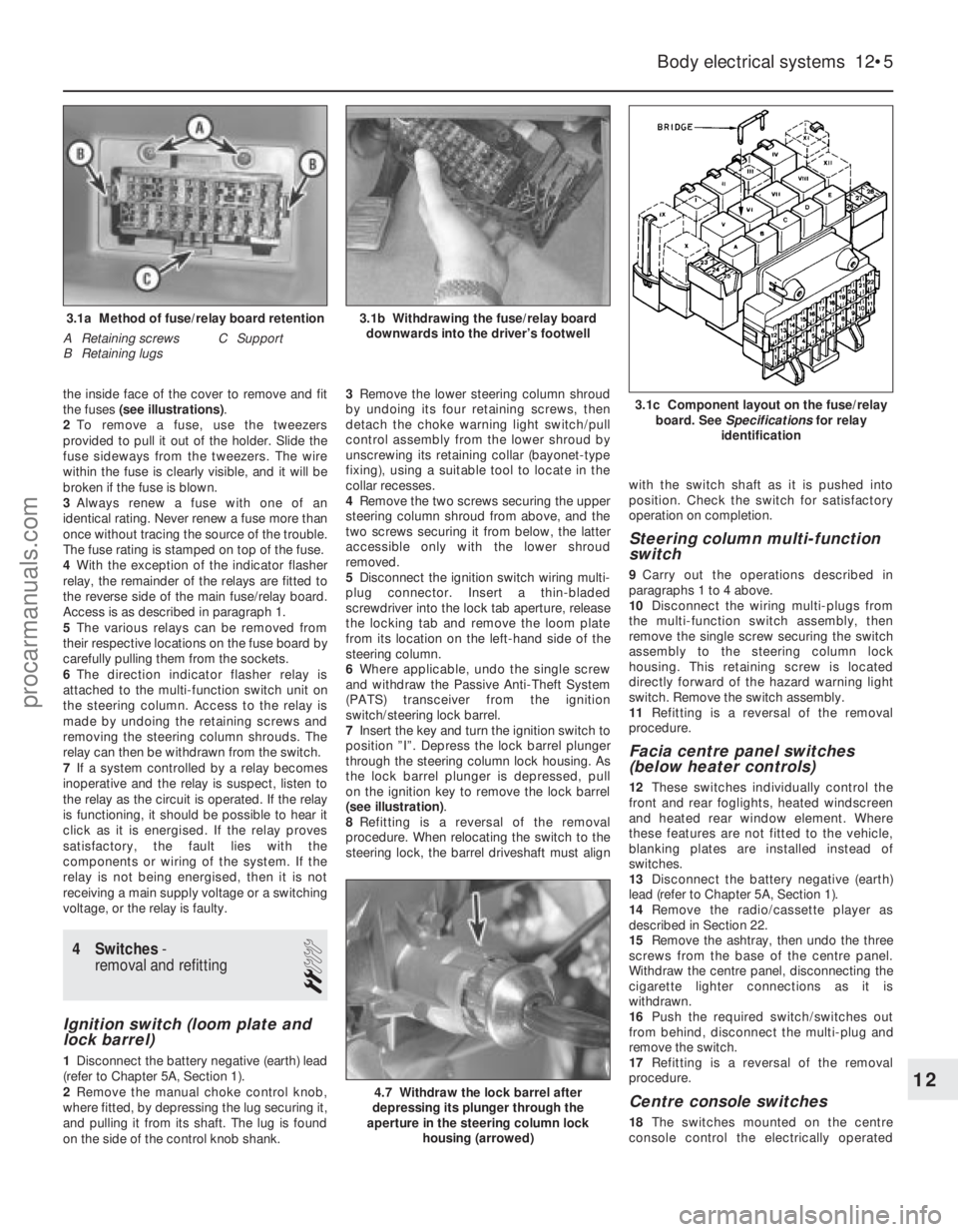
the inside face of the cover to remove and fit
the fuses (see illustrations) .
2 To remove a fuse, use the tweezers
provided to pull it out of the holder. Slide the
fuse sideways from the tweezers. The wire
within the fuse is clearly visible, and it will be
broken if the fuse is blown.
3 Always renew a fuse with one of an
identical rating. Never renew a fuse more than
once without tracing the source of the trouble.
The fuse rating is stamped on top of the fuse.
4 With the exception of the indicator flasher
relay, the remainder of the relays are fitted to
the reverse side of the main fuse/relay board.
Access is as described in paragraph 1.
5 The various relays can be removed from
their respective locations on the fuse board by
carefully pulling them from the sockets.
6 The direction indicator flasher relay is
attached to the multi-function switch unit on
the steering column. Access to the relay is
made by undoing the retaining screws and
removing the steering column shrouds. The
relay can then be withdrawn from the switch.
7 If a system controlled by a relay becomes
inoperative and the relay is suspect, listen to
the relay as the circuit is operated. If the relay
is functioning, it should be possible to hear it
click as it is energised. If the relay proves
satisfactory, the fault lies with the
components or wiring of the system. If the
relay is not being energised, then it is not
receiving a main supply voltage or a switching
voltage, or the relay is faulty.
4 Switches -
removal and refitting
2
Ignition switch (loom plate and
lock barrel)
1 Disconnect the battery negative (earth) lead
(refer to Chapter 5A, Section 1).
2 Remove the manual choke control knob,
where fitted, by depressing the lug securing it,
and pulling it from its shaft. The lug is found
on the side of the control knob shank. 3
Remove the lower steering column shroud
by undoing its four retaining screws, then
detach the choke warning light switch/pull
control assembly from the lower shroud by
unscrewing its retaining collar (bayonet-type
fixing), using a suitable tool to locate in the
collar recesses.
4 Remove the two screws securing the upper
steering column shroud from above, and the
two screws securing it from below, the latter
accessible only with the lower shroud
removed.
5 Disconnect the ignition switch wiring multi-
plug connector. Insert a thin-bladed
screwdriver into the lock tab aperture, release
the locking tab and remove the loom plate
from its location on the left-hand side of the
steering column.
6 Where applicable, undo the single screw
and withdraw the Passive Anti-Theft System
(PATS) transceiver from the ignition
switch/steering lock barrel.
7 Insert the key and turn the ignition switch to
position ”I”. Depress the lock barrel plunger
through the steering column lock housing. As
the lock barrel plunger is depressed, pull
on the ignition key to remove the lock barrel
(see illustration) .
8 Refitting is a reversal of the removal
procedure. When relocating the switch to the
steering lock, the barrel driveshaft must align with the switch shaft as it is pushed into
position. Check the switch for satisfactory
operation on completion.
Steering column multi-function
switch
9
Carry out the operations described in
paragraphs 1 to 4 above.
10 Disconnect the wiring multi-plugs from
the multi-function switch assembly, then
remove the single screw securing the switch
assembly to the steering column lock
housing. This retaining screw is located
directly forward of the hazard warning light
switch. Remove the switch assembly.
11 Refitting is a reversal of the removal
procedure.
Facia centre panel switches
(below heater controls)
12 These switches individually control the
front and rear foglights, heated windscreen
and heated rear window element. Where
these features are not fitted to the vehicle,
blanking plates are installed instead of
switches.
13 Disconnect the battery negative (earth)
lead (refer to Chapter 5A, Section 1).
14 Remove the radio/cassette player as
described in Section 22.
15 Remove the ashtray, then undo the three
screws from the base of the centre panel.
Withdraw the centre panel, disconnecting the
cigarette lighter connections as it is
withdrawn.
16 Push the required switch/switches out
from behind, disconnect the multi-plug and
remove the switch.
17 Refitting is a reversal of the removal
procedure.
Centre console switches
18 The switches mounted on the centre
console control the electrically operated
Body electrical systems 12•5
3.1c Component layout on the fuse/relay board. See Specifications for relay
identification
3.1b Withdrawing the fuse/relay board downwards into the driver’s footwell3.1a Method of fuse/relay board retention
A Retaining screws C Support
B Retaining lugs
4.7 Withdraw the lock barrel after
depressing its plunger through the
aperture in the steering column lock
housing (arrowed)12
1595Ford Fiesta Remakeprocarmanuals.com
http://vnx.su
Page 240 of 296
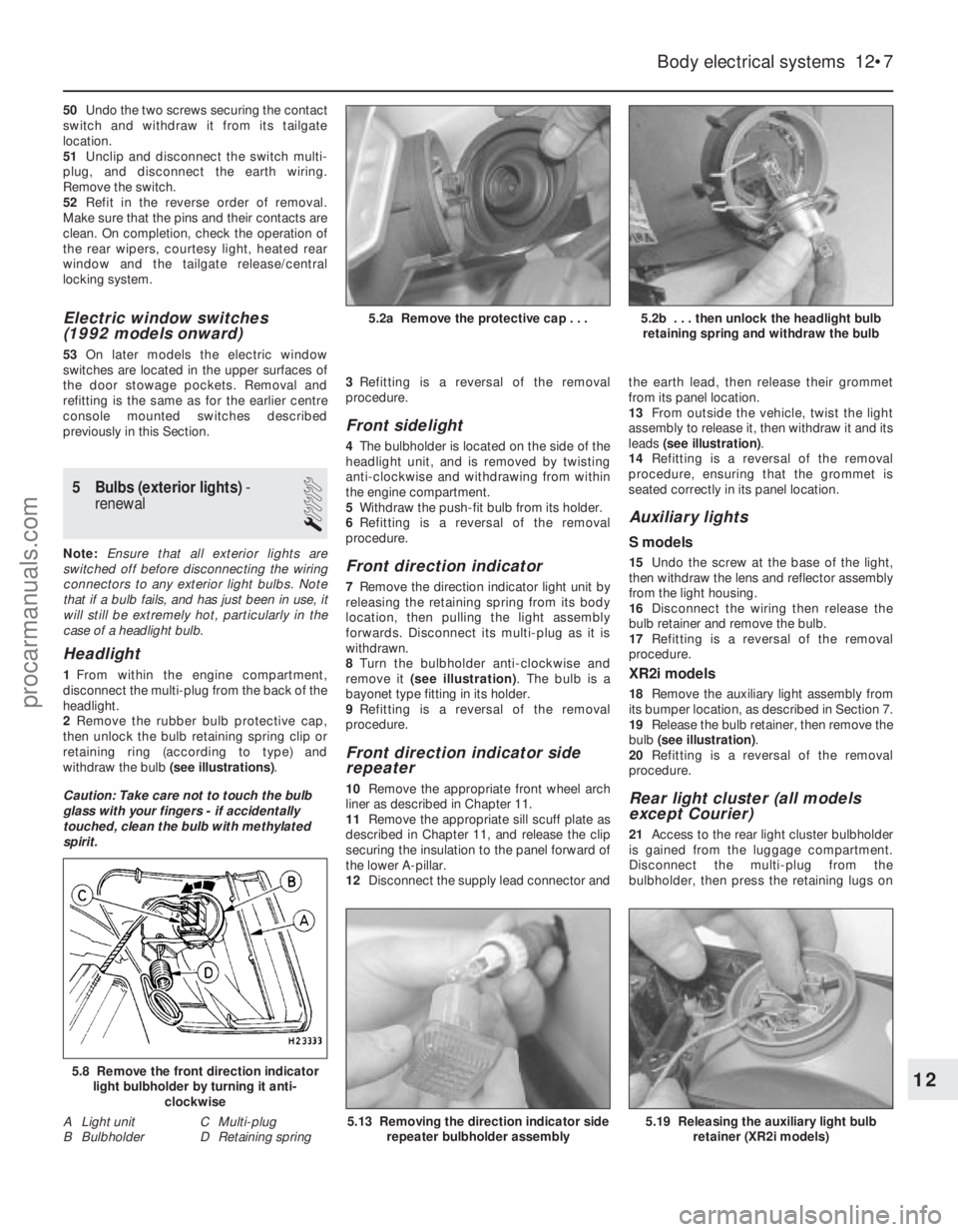
50Undo the two screws securing the contact
switch and withdraw it from its tailgate
location.
51 Unclip and disconnect the switch multi-
plug, and disconnect the earth wiring.
Remove the switch.
52 Refit in the reverse order of removal.
Make sure that the pins and their contacts are
clean. On completion, check the operation of
the rear wipers, courtesy light, heated rear
window and the tailgate release/central
locking system.
Electric window switches
(1992 models onward)
53 On later models the electric window
switches are located in the upper surfaces of
the door stowage pockets. Removal and
refitting is the same as for the earlier centre
console mounted switches described
previously in this Section.
5 Bulbs (exterior lights) -
renewal
1
Note: Ensure that all exterior lights are
switched off before disconnecting the wiring
connectors to any exterior light bulbs. Note
that if a bulb fails, and has just been in use, it
will still be extremely hot, particularly in the
case of a headlight bulb.
Headlight
1 From within the engine compartment,
disconnect the multi-plug from the back of the
headlight.
2 Remove the rubber bulb protective cap,
then unlock the bulb retaining spring clip or
retaining ring (according to type) and
withdraw the bulb (see illustrations).
Caution: Take care not to touch the bulb
glass with your fingers - if accidentally
touched, clean the bulb with methylated
spirit. 3
Refitting is a reversal of the removal
procedure.
Front sidelight
4 The bulbholder is located on the side of the
headlight unit, and is removed by twisting
anti-clockwise and withdrawing from within
the engine compartment.
5 Withdraw the push-fit bulb from its holder.
6 Refitting is a reversal of the removal
procedure.
Front direction indicator
7 Remove the direction indicator light unit by
releasing the retaining spring from its body
location, then pulling the light assembly
forwards. Disconnect its multi-plug as it is
withdrawn.
8 Turn the bulbholder anti-clockwise and
remove it (see illustration) . The bulb is a
bayonet type fitting in its holder.
9 Refitting is a reversal of the removal
procedure.
Front direction indicator side
repeater
10 Remove the appropriate front wheel arch
liner as described in Chapter 11.
11 Remove the appropriate sill scuff plate as
described in Chapter 11, and release the clip
securing the insulation to the panel forward of
the lower A-pillar.
12 Disconnect the supply lead connector and the earth lead, then release their grommet
from its panel location.
13
From outside the vehicle, twist the light
assembly to release it, then withdraw it and its
leads (see illustration) .
14 Refitting is a reversal of the removal
procedure, ensuring that the grommet is
seated correctly in its panel location.
Auxiliary lights
S models
15 Undo the screw at the base of the light,
then withdraw the lens and reflector assembly
from the light housing.
16 Disconnect the wiring then release the
bulb retainer and remove the bulb.
17 Refitting is a reversal of the removal
procedure.
XR2i models
18 Remove the auxiliary light assembly from
its bumper location, as described in Section 7.
19 Release the bulb retainer, then remove the
bulb (see illustration) .
20 Refitting is a reversal of the removal
procedure.
Rear light cluster (all models
except Courier)
21 Access to the rear light cluster bulbholder
is gained from the luggage compartment.
Disconnect the multi-plug from the
bulbholder, then press the retaining lugs on
Body electrical systems 12•7
5.2b . . . then unlock the headlight bulb retaining spring and withdraw the bulb5.2a Remove the protective cap . . .
5.19 Releasing the auxiliary light bulb retainer (XR2i models)5.13 Removing the direction indicator siderepeater bulbholder assembly
5.8 Remove the front direction indicatorlight bulbholder by turning it anti-
clockwise
A Light unit C Multi-plug
B Bulbholder D Retaining spring12
1595Ford Fiesta Remakeprocarmanuals.com
http://vnx.su
Page 241 of 296
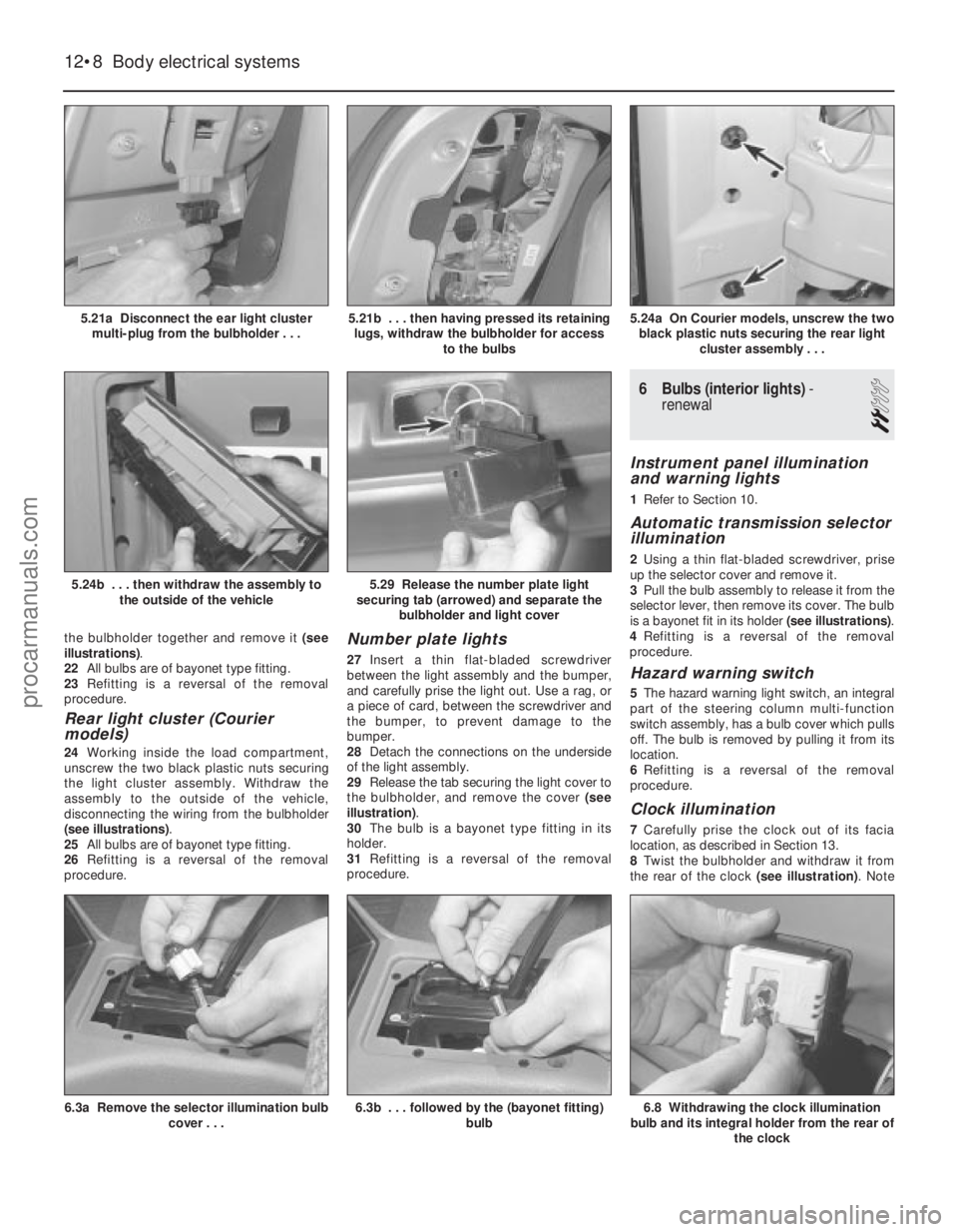
the bulbholder together and remove it (see
illustrations) .
22 All bulbs are of bayonet type fitting.
23 Refitting is a reversal of the removal
procedure.
Rear light cluster (Courier
models)
24 Working inside the load compartment,
unscrew the two black plastic nuts securing
the light cluster assembly. Withdraw the
assembly to the outside of the vehicle,
disconnecting the wiring from the bulbholder
(see illustrations) .
25 All bulbs are of bayonet type fitting.
26 Refitting is a reversal of the removal
procedure.
Number plate lights
27 Insert a thin flat-bladed screwdriver
between the light assembly and the bumper,
and carefully prise the light out. Use a rag, or
a piece of card, between the screwdriver and
the bumper, to prevent damage to the
bumper.
28 Detach the connections on the underside
of the light assembly.
29 Release the tab securing the light cover to
the bulbholder, and remove the cover (see
illustration) .
30 The bulb is a bayonet type fitting in its
holder.
31 Refitting is a reversal of the removal
procedure.
6 Bulbs (interior lights) -
renewal
2
Instrument panel illumination
and warning lights
1 Refer to Section 10.
Automatic transmission selector
illumination
2Using a thin flat-bladed screwdriver, prise
up the selector cover and remove it.
3 Pull the bulb assembly to release it from the
selector lever, then remove its cover. The bulb
is a bayonet fit in its holder (see illustrations).
4 Refitting is a reversal of the removal
procedure.
Hazard warning switch
5 The hazard warning light switch, an integral
part of the steering column multi-function
switch assembly, has a bulb cover which pulls
off. The bulb is removed by pulling it from its
location.
6 Refitting is a reversal of the removal
procedure.
Clock illumination
7 Carefully prise the clock out of its facia
location, as described in Section 13.
8 Twist the bulbholder and withdraw it from
the rear of the clock (see illustration). Note
12•8Body electrical systems
6.8 Withdrawing the clock illumination
bulb and its integral holder from the rear of
the clock6.3b . . . followed by the (bayonet fitting) bulb6.3a Remove the selector illumination bulbcover . . .
5.29 Release the number plate light
securing tab (arrowed) and separate the bulbholder and light cover5.24b . . . then withdraw the assembly to
the outside of the vehicle
5.24a On Courier models, unscrew the twoblack plastic nuts securing the rear light cluster assembly . . .5.21b . . . then having pressed its retaininglugs, withdraw the bulbholder for access to the bulbs5.21a Disconnect the ear light clustermulti-plug from the bulbholder . . .
1595Ford Fiesta Remakeprocarmanuals.com
http://vnx.su
Page 242 of 296
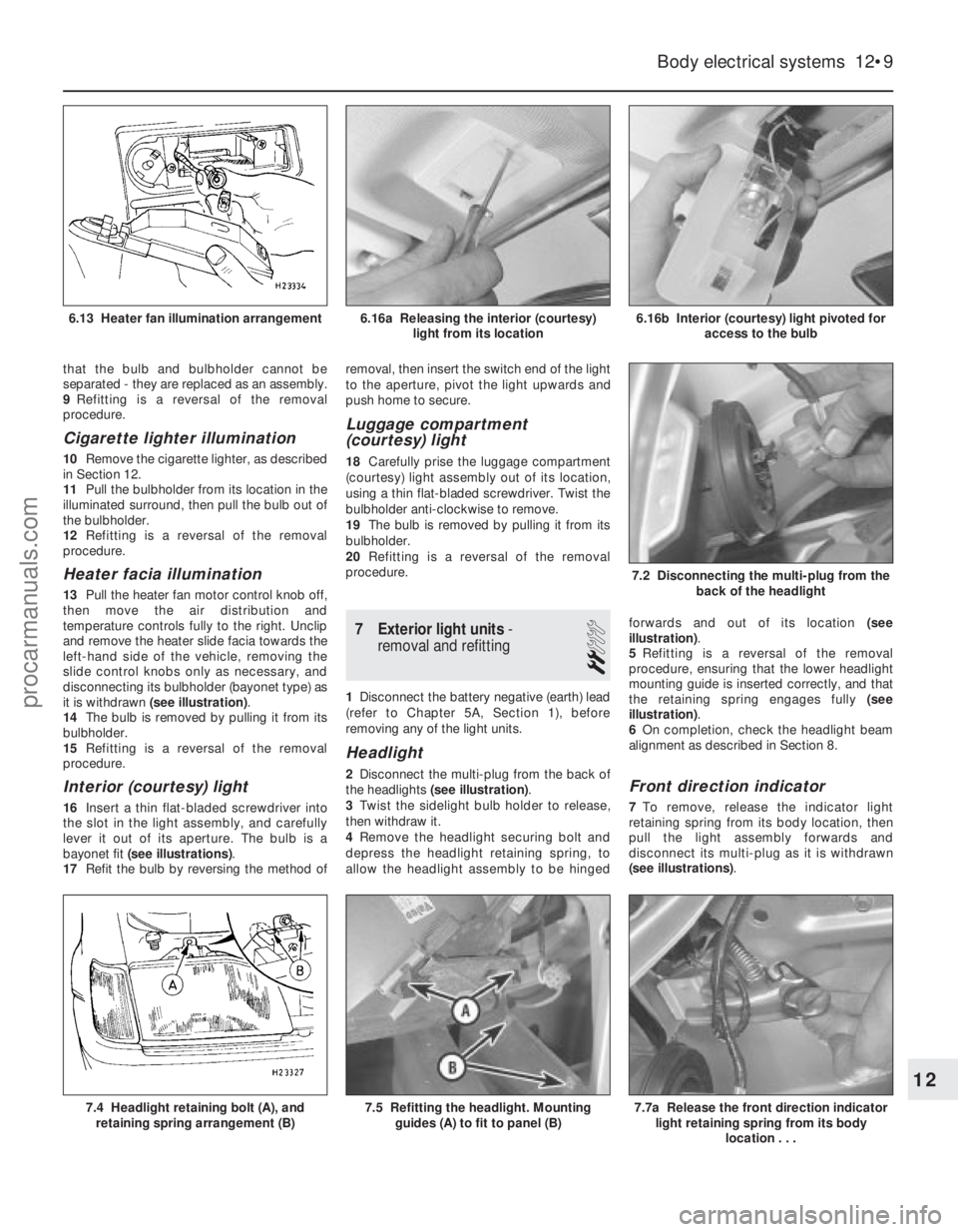
that the bulb and bulbholder cannot be
separated - they are replaced as an assembly.
9Refitting is a reversal of the removal
procedure.
Cigarette lighter illumination
10 Remove the cigarette lighter, as described
in Section 12.
11 Pull the bulbholder from its location in the
illuminated surround, then pull the bulb out of
the bulbholder.
12 Refitting is a reversal of the removal
procedure.
Heater facia illumination
13 Pull the heater fan motor control knob off,
then move the air distribution and
temperature controls fully to the right. Unclip
and remove the heater slide facia towards the
left-hand side of the vehicle, removing the
slide control knobs only as necessary, and
disconnecting its bulbholder (bayonet type) as
it is withdrawn (see illustration) .
14 The bulb is removed by pulling it from its
bulbholder.
15 Refitting is a reversal of the removal
procedure.
Interior (courtesy) light
16 Insert a thin flat-bladed screwdriver into
the slot in the light assembly, and carefully
lever it out of its aperture. The bulb is a
bayonet fit (see illustrations) .
17 Refit the bulb by reversing the method of removal, then insert the switch end of the light
to the aperture, pivot the light upwards and
push home to secure.
Luggage compartment
(courtesy) light
18
Carefully prise the luggage compartment
(courtesy) light assembly out of its location,
using a thin flat-bladed screwdriver. Twist the
bulbholder anti-clockwise to remove.
19 The bulb is removed by pulling it from its
bulbholder.
20 Refitting is a reversal of the removal
procedure.
7 Exterior light units -
removal and refitting
2
1 Disconnect the battery negative (earth) lead
(refer to Chapter 5A, Section 1), before
removing any of the light units.
Headlight
2 Disconnect the multi-plug from the back of
the headlights (see illustration) .
3 Twist the sidelight bulb holder to release,
then withdraw it.
4 Remove the headlight securing bolt and
depress the headlight retaining spring, to
allow the headlight assembly to be hinged forwards and out of its location
(see
illustration) .
5 Refitting is a reversal of the removal
procedure, ensuring that the lower headlight
mounting guide is inserted correctly, and that
the retaining spring engages fully (see
illustration) .
6 On completion, check the headlight beam
alignment as described in Section 8.Front direction indicator
7 To remove, release the indicator light
retaining spring from its body location, then
pull the light assembly forwards and
disconnect its multi-plug as it is withdrawn
(see illustrations) .
Body electrical systems 12•9
6.16b Interior (courtesy) light pivoted for
access to the bulb
7.2 Disconnecting the multi-plug from the
back of the headlight
6.16a Releasing the interior (courtesy)light from its location6.13 Heater fan illumination arrangement
7.7a Release the front direction indicatorlight retaining spring from its body
location . . .7.5 Refitting the headlight. Mountingguides (A) to fit to panel (B)7.4 Headlight retaining bolt (A), andretaining spring arrangement (B)
12
1595Ford Fiesta Remakeprocarmanuals.com
http://vnx.su
Page 243 of 296
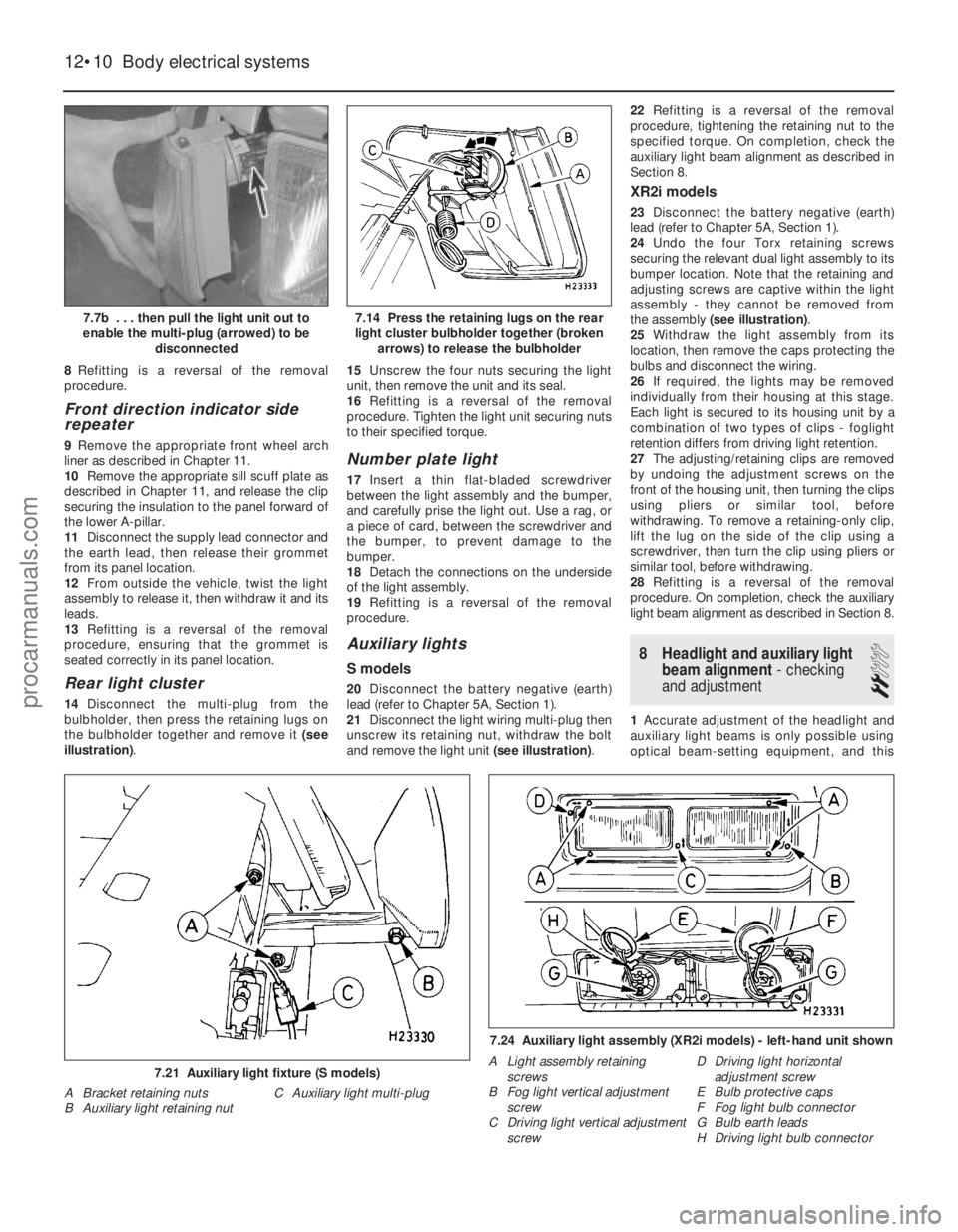
8Refitting is a reversal of the removal
procedure.
Front direction indicator side
repeater
9 Remove the appropriate front wheel arch
liner as described in Chapter 11.
10 Remove the appropriate sill scuff plate as
described in Chapter 11, and release the clip
securing the insulation to the panel forward of
the lower A-pillar.
11 Disconnect the supply lead connector and
the earth lead, then release their grommet
from its panel location.
12 From outside the vehicle, twist the light
assembly to release it, then withdraw it and its
leads.
13 Refitting is a reversal of the removal
procedure, ensuring that the grommet is
seated correctly in its panel location.
Rear light cluster
14 Disconnect the multi-plug from the
bulbholder, then press the retaining lugs on
the bulbholder together and remove it (see
illustration) . 15
Unscrew the four nuts securing the light
unit, then remove the unit and its seal.
16 Refitting is a reversal of the removal
procedure. Tighten the light unit securing nuts
to their specified torque.
Number plate light
17 Insert a thin flat-bladed screwdriver
between the light assembly and the bumper,
and carefully prise the light out. Use a rag, or
a piece of card, between the screwdriver and
the bumper, to prevent damage to the
bumper.
18 Detach the connections on the underside
of the light assembly.
19 Refitting is a reversal of the removal
procedure.
Auxiliary lights
S models
20 Disconnect the battery negative (earth)
lead (refer to Chapter 5A, Section 1).
21 Disconnect the light wiring multi-plug then
unscrew its retaining nut, withdraw the bolt
and remove the light unit (see illustration).22
Refitting is a reversal of the removal
procedure, tightening the retaining nut to the
specified torque. On completion, check the
auxiliary light beam alignment as described in
Section 8.
XR2i models
23 Disconnect the battery negative (earth)
lead (refer to Chapter 5A, Section 1).
24 Undo the four Torx retaining screws
securing the relevant dual light assembly to its
bumper location. Note that the retaining and
adjusting screws are captive within the light
assembly - they cannot be removed from
the assembly (see illustration) .
25 Withdraw the light assembly from its
location, then remove the caps protecting the
bulbs and disconnect the wiring.
26 If required, the lights may be removed
individually from their housing at this stage.
Each light is secured to its housing unit by a
combination of two types of clips - foglight
retention differs from driving light retention.
27 The adjusting/retaining clips are removed
by undoing the adjustment screws on the
front of the housing unit, then turning the clips
using pliers or similar tool, before
withdrawing. To remove a retaining-only clip,
lift the lug on the side of the clip using a
screwdriver, then turn the clip using pliers or
similar tool, before withdrawing.
28 Refitting is a reversal of the removal
procedure. On completion, check the auxiliary
light beam alignment as described in Section 8.
8 Headlight and auxiliary light
beam alignment - checking
and adjustment
2
1 Accurate adjustment of the headlight and
auxiliary light beams is only possible using
optical beam-setting equipment, and this
12•10 Body electrical systems
7.24 Auxiliary light assembly (XR2i models) - left-hand unit shown
A Light assembly retaining screws
B Fog light vertical adjustment screw
C Driving light vertical adjustment screw D Driving light horizontal
adjustment screw
E Bulb protective caps
F Fog light bulb connector
G Bulb earth leads
H Driving light bulb connector
7.21 Auxiliary light fixture (S models)
A Bracket retaining nuts C Auxiliary light multi-plug
B Auxiliary light retaining nut
7.14 Press the retaining lugs on the rear
light cluster bulbholder together (broken arrows) to release the bulbholder7.7b . . . then pull the light unit out to
enable the multi-plug (arrowed) to be disconnected
1595Ford Fiesta Remakeprocarmanuals.com
http://vnx.su
Page 244 of 296
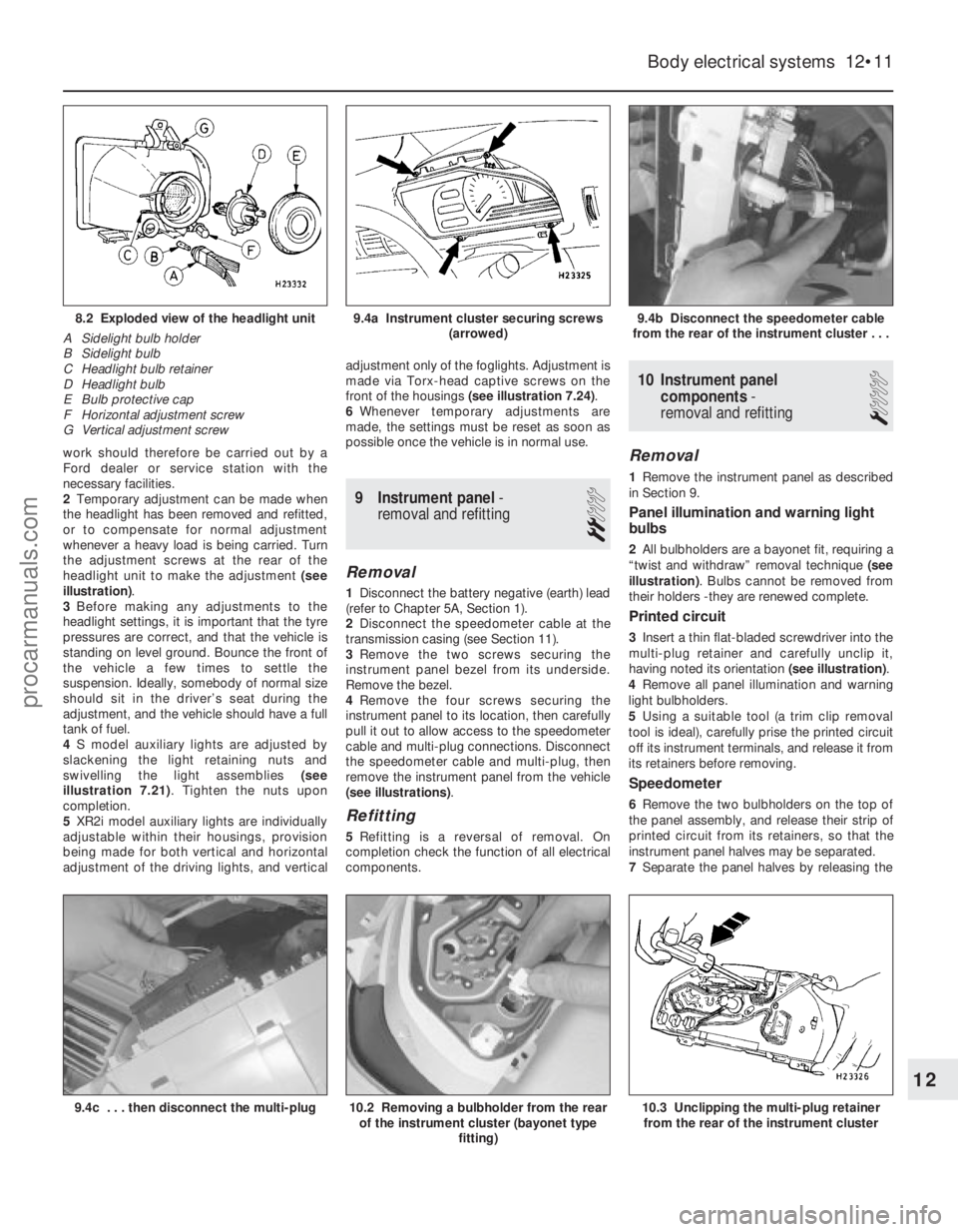
work should therefore be carried out by a
Ford dealer or service station with the
necessary facilities.
2Temporary adjustment can be made when
the headlight has been removed and refitted,
or to compensate for normal adjustment
whenever a heavy load is being carried. Turn
the adjustment screws at the rear of the
headlight unit to make the adjustment (see
illustration) .
3 Before making any adjustments to the
headlight settings, it is important that the tyre
pressures are correct, and that the vehicle is
standing on level ground. Bounce the front of
the vehicle a few times to settle the
suspension. Ideally, somebody of normal size
should sit in the driver’s seat during the
adjustment, and the vehicle should have a full
tank of fuel.
4 S model auxiliary lights are adjusted by
slackening the light retaining nuts and
swivelling the light assemblies (see
illustration 7.21) . Tighten the nuts upon
completion.
5 XR2i model auxiliary lights are individually
adjustable within their housings, provision
being made for both vertical and horizontal
adjustment of the driving lights, and vertical adjustment only of the foglights. Adjustment is
made via Torx-head captive screws on the
front of the housings
(see illustration 7.24) .
6 Whenever temporary adjustments are
made, the settings must be reset as soon as
possible once the vehicle is in normal use.
9 Instrument panel -
removal and refitting
2
Removal
1 Disconnect the battery negative (earth) lead
(refer to Chapter 5A, Section 1).
2 Disconnect the speedometer cable at the
transmission casing (see Section 11).
3 Remove the two screws securing the
instrument panel bezel from its underside.
Remove the bezel.
4 Remove the four screws securing the
instrument panel to its location, then carefully
pull it out to allow access to the speedometer
cable and multi-plug connections. Disconnect
the speedometer cable and multi-plug, then
remove the instrument panel from the vehicle
(see illustrations) .
Refitting
5Refitting is a reversal of removal. On
completion check the function of all electrical
components.
10 Instrument panel
components -
removal and refitting
1
Removal
1 Remove the instrument panel as described
in Section 9.
Panel illumination and warning light
bulbs
2 All bulbholders are a bayonet fit, requiring a
“twist and withdraw” removal technique (see
illustration) . Bulbs cannot be removed from
their holders -they are renewed complete.
Printed circuit
3 Insert a thin flat-bladed screwdriver into the
multi-plug retainer and carefully unclip it,
having noted its orientation (see illustration).
4 Remove all panel illumination and warning
light bulbholders.
5 Using a suitable tool (a trim clip removal
tool is ideal), carefully prise the printed circuit
off its instrument terminals, and release it from
its retainers before removing.
Speedometer
6 Remove the two bulbholders on the top of
the panel assembly, and release their strip of
printed circuit from its retainers, so that the
instrument panel halves may be separated.
7 Separate the panel halves by releasing the
Body electrical systems 12•11
9.4b Disconnect the speedometer cable
from the rear of the instrument cluster . . .9.4a Instrument cluster securing screws (arrowed)8.2 Exploded view of the headlight unit
A Sidelight bulb holder
B Sidelight bulb
C Headlight bulb retainer
D Headlight bulb
E Bulb protective cap
F Horizontal adjustment screw
G Vertical adjustment screw
10.3 Unclipping the multi-plug retainer from the rear of the instrument cluster10.2 Removing a bulbholder from the rear of the instrument cluster (bayonet type
fitting)9.4c . . . then disconnect the multi-plug
12
1595Ford Fiesta Remakeprocarmanuals.com
http://vnx.su
Page 249 of 296
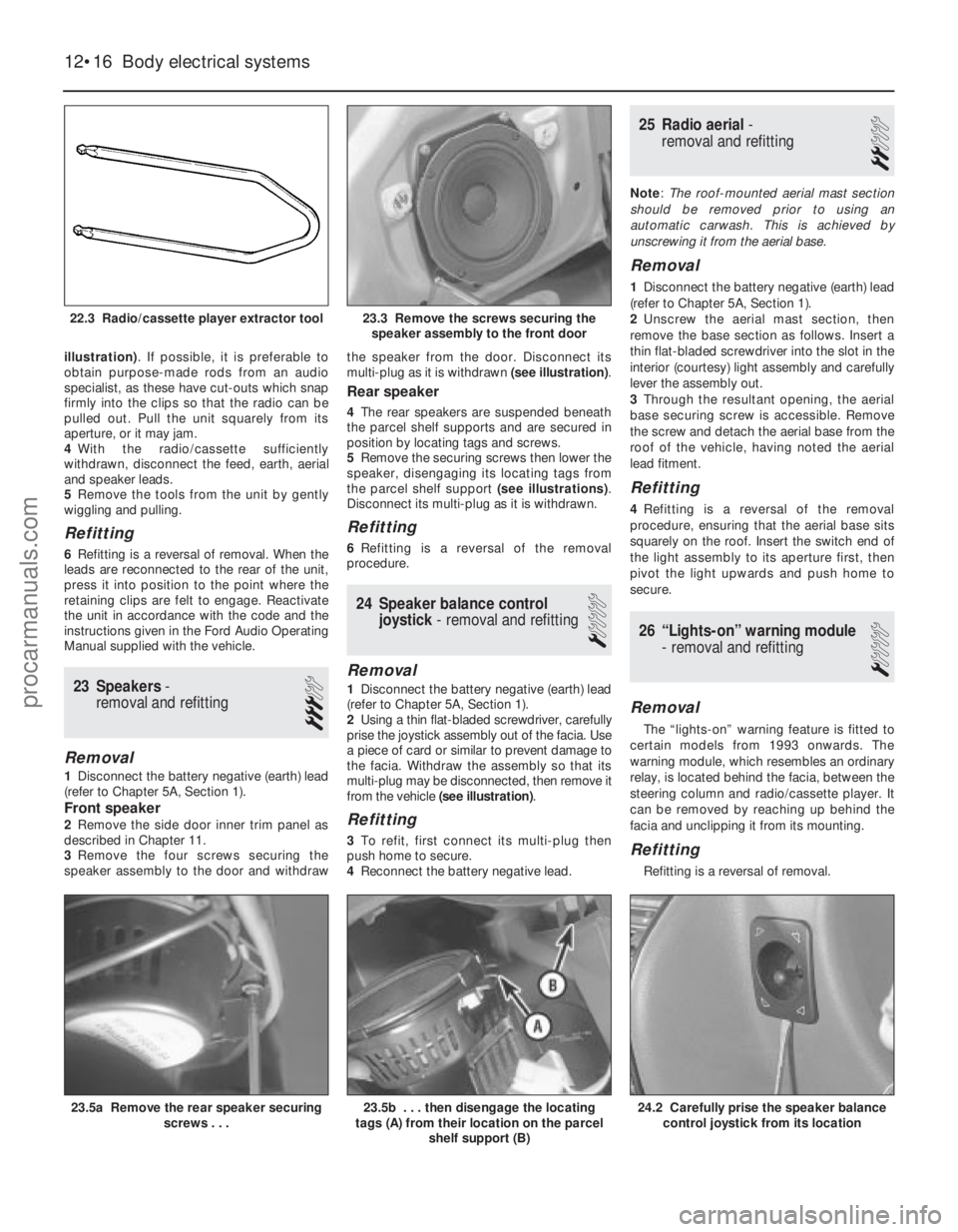
illustration). If possible, it is preferable to
obtain purpose-made rods from an audio
specialist, as these have cut-outs which snap
firmly into the clips so that the radio can be
pulled out. Pull the unit squarely from its
aperture, or it may jam.
4 With the radio/cassette sufficiently
withdrawn, disconnect the feed, earth, aerial
and speaker leads.
5 Remove the tools from the unit by gently
wiggling and pulling.
Refitting
6 Refitting is a reversal of removal. When the
leads are reconnected to the rear of the unit,
press it into position to the point where the
retaining clips are felt to engage. Reactivate
the unit in accordance with the code and the
instructions given in the Ford Audio Operating
Manual supplied with the vehicle.
23 Speakers -
removal and refitting
3
Removal
1 Disconnect the battery negative (earth) lead
(refer to Chapter 5A, Section 1).
Front speaker
2 Remove the side door inner trim panel as
described in Chapter 11.
3 Remove the four screws securing the
speaker assembly to the door and withdraw the speaker from the door. Disconnect its
multi-plug as it is withdrawn
(see illustration).
Rear speaker
4The rear speakers are suspended beneath
the parcel shelf supports and are secured in
position by locating tags and screws.
5 Remove the securing screws then lower the
speaker, disengaging its locating tags from
the parcel shelf support (see illustrations).
Disconnect its multi-plug as it is withdrawn.
Refitting
6 Refitting is a reversal of the removal
procedure.
24 Speaker balance control
joystick - removal and refitting
1
Removal
1Disconnect the battery negative (earth) lead
(refer to Chapter 5A, Section 1).
2 Using a thin flat-bladed screwdriver, carefully
prise the joystick assembly out of the facia. Use
a piece of card or similar to prevent damage to
the facia. Withdraw the assembly so that its
multi-plug may be disconnected, then remove it
from the vehicle (see illustration) .
Refitting
3To refit, first connect its multi-plug then
push home to secure.
4 Reconnect the battery negative lead.
25 Radio aerial -
removal and refitting
2
Note : The roof-mounted aerial mast section
should be removed prior to using an
automatic carwash. This is achieved by
unscrewing it from the aerial base.
Removal
1 Disconnect the battery negative (earth) lead
(refer to Chapter 5A, Section 1).
2 Unscrew the aerial mast section, then
remove the base section as follows. Insert a
thin flat-bladed screwdriver into the slot in the
interior (courtesy) light assembly and carefully
lever the assembly out.
3 Through the resultant opening, the aerial
base securing screw is accessible. Remove
the screw and detach the aerial base from the
roof of the vehicle, having noted the aerial
lead fitment.
Refitting
4 Refitting is a reversal of the removal
procedure, ensuring that the aerial base sits
squarely on the roof. Insert the switch end of
the light assembly to its aperture first, then
pivot the light upwards and push home to
secure.
26 “Lights-on” warning module
- removal and refitting
1
Removal
The “lights-on” warning feature is fitted to
certain models from 1993 onwards. The
warning module, which resembles an ordinary
relay, is located behind the facia, between the
steering column and radio/cassette player. It
can be removed by reaching up behind the
facia and unclipping it from its mounting.
Refitting
Refitting is a reversal of removal.
12•16 Body electrical systems
24.2 Carefully prise the speaker balance control joystick from its location23.5b . . . then disengage the locating
tags (A) from their location on the parcel
shelf support (B)23.5a Remove the rear speaker securing screws . . .
23.3 Remove the screws securing thespeaker assembly to the front door22.3 Radio/cassette player extractor tool
1595Ford Fiesta Remakeprocarmanuals.com
http://vnx.su
Page 261 of 296
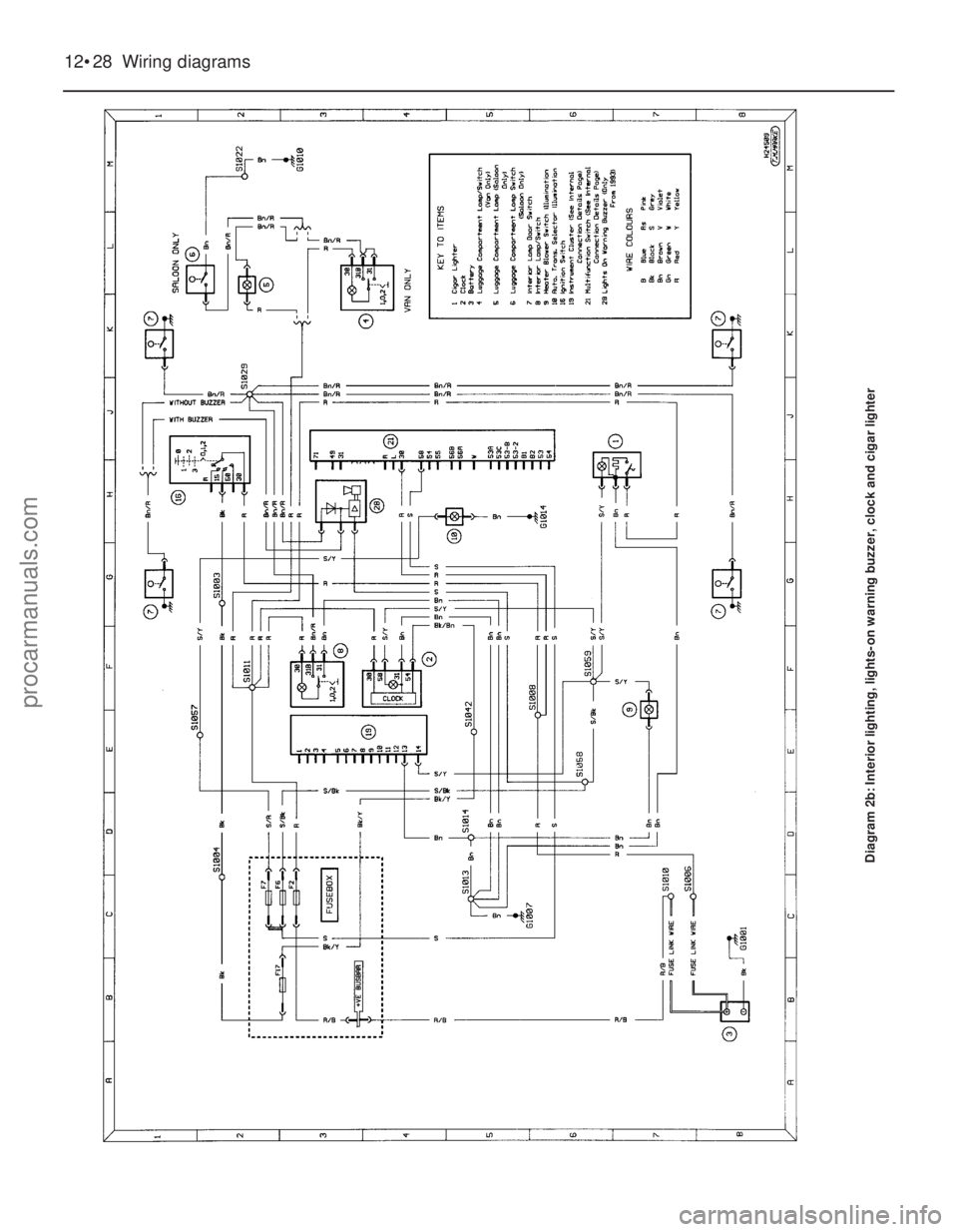
12•28 Wiring diagrams
Diagram 2b: Interior lighting, lights-on warning buzzer, clock and cigar\
lighter
1595Ford Fiesta Remakeprocarmanuals.com
http://vnx.su
Page 277 of 296
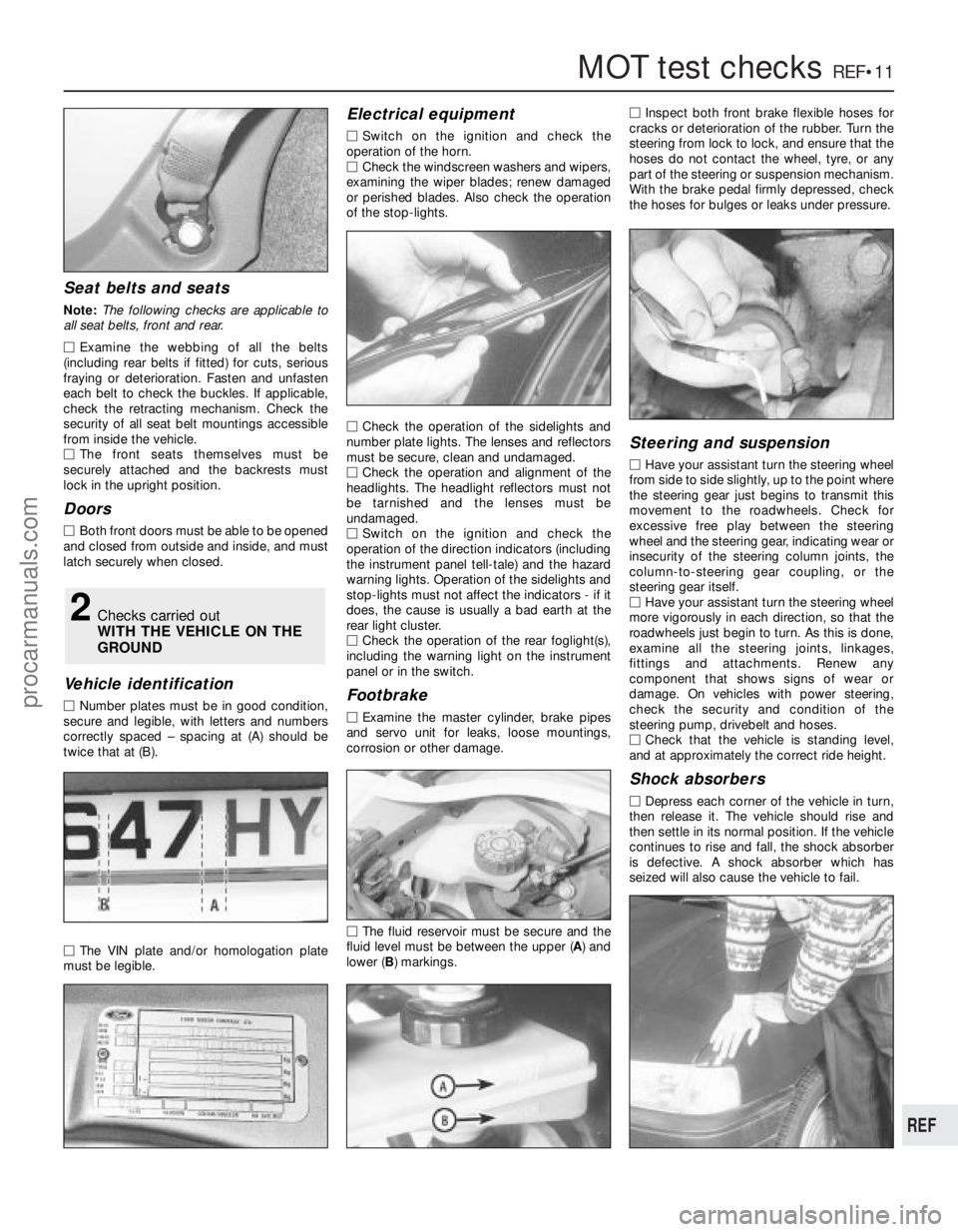
1595 Ford Fiesta Remake
MOT test checksREF•11
REF
Seat belts and seats
Note: The following checks are applicable to
all seat belts, front and rear.
M Examine the webbing of all the belts
(including rear belts if fitted) for cuts, serious
fraying or deterioration. Fasten and unfasten
each belt to check the buckles. If applicable,
check the retracting mechanism. Check the
security of all seat belt mountings accessible
fr om inside the vehicle.
M The front seats themselves must be
secur ely attached and the backrests must
lock in the upright position.
Doors
M Both front doors must be able to be opened
and closed from outside and inside, and must
latch securely when closed.
V ehicle identification
M Number plates must be in good condition,
secur e and legible, with letters and numbers
corr ectly spaced – spacing at (A) should be
twice that at (B).
M The VIN plate and/or homologation plate
must be legible.
Electrical equipment
M Switch on the ignition and check the
operation of the horn.
M Check the windscreen washers and wipers,
examining the wiper blades; renew damaged
or perished blades. Also check the operation
of the stop-lights.
M Check the operation of the sidelights and
number plate lights. The lenses and reflectors
must be secure, clean and undamaged.
M Check the operation and alignment of the
headlights. The headlight reflectors must not
be tarnished and the lenses must be
undamaged.
M Switch on the ignition and check the
operation of the direction indicators (including
the instrument panel tell-tale) and the hazard
war ning lights. Operation of the sidelights and
stop-lights must not affect the indicators - if it
does, the cause is usually a bad earth at the
r ear light cluster.
M Check the operation of the rear foglight(s),
including the warning light on the instrument
panel or in the switch.
Footbrake
M Examine the master cylinder, brake pipes
and servo unit for leaks, loose mountings,
corr osion or other damage.
M The fluid reservoir must be secure and the
fluid level must be between the upper ( A) and
lower ( B) markings. M
Inspect both front brake flexible hoses for
cracks or deterioration of the rubber . Turn the
steering from lock to lock, and ensure that the
hoses do not contact the wheel, tyre, or any
part of the steering or suspension mechanism.
With the brake pedal firmly depressed, check
the hoses for bulges or leaks under pressure.
Steering and suspension
M Have your assistant turn the steering wheel
fr om side to side slightly, up to the point where
the steering gear just begins to transmit this
movement to the roadwheels. Check for
excessive free play between the steering
wheel and the steering gear, indicating wear or
insecurity of the steering column joints, the
column-to-steering gear coupling, or the
steering gear itself.
M Have your assistant turn the steering wheel
mor e vigorously in each direction, so that the
r oadwheels just begin to turn. As this is done,
examine all the steering joints, linkages,
fittings and attachments. Renew any
component that shows signs of wear or
damage. On vehicles with power steering,
check the security and condition of the
steering pump, drivebelt and hoses.
M Check that the vehicle is standing level,
and at approximately the correct ride height.
Shock absorbers
M Depr ess each corner of the vehicle in turn,
then release it. The vehicle should rise and
then settle in its normal position. If the vehicle
continues to rise and fall, the shock absorber
is defective. A shock absorber which has
seized will also cause the vehicle to fail.
2Checks carried out
WITH THE VEHICLE ON THE
GROUND
procarmanuals.com
http://vnx.su